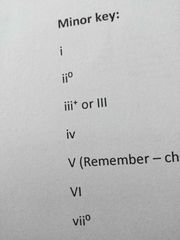![]()
![]()
![]()
Use LEFT and RIGHT arrow keys to navigate between flashcards;
Use UP and DOWN arrow keys to flip the card;
H to show hint;
A reads text to speech;
46 Cards in this Set
- Front
- Back
|
Simple time |
2 3 4 3 4 4 4 8 |
|
|
Compound time |
6 9 12 8 8 8 |
|
|
Irregular time |
5 7 5 7 8 8 4 4 |
|
|
tuplet |
2 notes played in time of 3 |
|
|
triplet |
3 notes played in time of 2 |
|
|
quintuplet |
5 notes played in the time of four |
|
|
sextuplet |
6 notes played in the time of four |
|
|
septuplet |
7 notes played in the time of 4 or six |
|
|
major scale |
ionian mode - 3-4 slurred - 7-8 slurred |
|
|
harmonic minor |
- 7th raised - 2-3 slurred - 7-8 slurred (up) - 5-6 slurred (down) |
|
|
melodic minor |
- raise 6th and 7th then lower - 2-3 slurred - 5-6 slurred |
|
|
natural minor |
- not raising 7ths - 2-3 slurred - 5-6 slurred |
|
|
symmetrical scales |
whole tone and chromatic |
|
|
Whole tone scale |
Consists of whole tones ONLY |
|
|
bass clef |
F clef |
|
|
Alto and tenor clef |
Both C clefs |
|
|
Sharps key signatures |
Sharps descending (2,3,2) in all EXCEPT tenor clef where it rises (1,2,2,2) |
|
|
Flats key signatures |
All falling |
|
|
Technical names |
1. Tonic 2. Super-tonic 3. Mediant 4. Sub-dominant 5. Dominant 6. Sub-mediant 7. Leading note 8. Tonic |
|
|
What beats can you not group together |
2 & 3 |
|
|
Which parts of beats can you not group together |
Second and third parts |
|
|
Transposing up a major third |
- what key are you in? - find new key a major third above your original key - transpose very note up a third (if a note doesn’t have an accidental you don’t have to add one either) |
|
|
Transposing up a minor third |
- name key signature (think major only) - find minor third above this key - transpose every note up |
|
|
Major key |
Back (Definition) |
|
|
Chromatic scale |
Consists of semitones ONLY |
|
|
Minor key |
Back (Definition) |
|
|
Perfect cadences |
V - I |
|
|
Plagal cadences |
IV - I |
|
|
Imperfect cadences |
I -V ii - V IV - V |
|
|
Interrupted cadences |
V - vi |
|
|
Passing 6/4 |
D R M (I6 - V6/4 - I) M R D S S S D T D
F S L (IV6 - I6/4 - IV) L S F D D D F M F |
|
|
Cadential 6/4 |
D T D. (I6/4 - V - I) M R D S S S |
|
|
Major key |

Back (Definition) |
|
|
Minor key |

Back (Definition) |
|
|
What is easier to read in descending order musically |
Easier to read by changing natural note to sharp or flat (instead of using naturals) |
|
|
Dorian mode |
Starts on second step of major scale (if c then starts on d) - has the same slurs as a major (therefore 1-2, 6-7) |
|
|
Mixolydian mode |
starts on the fifth step of a major scale - same slurs (therefore 3-4, 6-7) |
|
|
Aeolian mode |
Starts on sixth step - same slurs (therefore 2-3, 5-6) |
|
|
Intervals |
- perfect unison - major 2nd - major 3rd - perfect 4th - perfect 5th - major 6th - major 7th - perfect octave |
|
|
Soprano clef |
G clef |
|
|
Front (Term) |
Back (Definition) |
|
|
Appogiatura |
Type of accented incomplete neighbor tone approached skip-wise from one chord tone and resolved stepwise to another chord tone (“overshooting” chord tone) |
|
|
Mordent |
Back (Definition) |
|
|
Turn |
Back (Definition) |
|
|
AcciaccaturaE |
Back (Definition) |
|
|
Echappee |
Back (Definition) |

